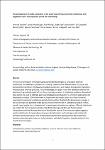The development of arable cultivation in the south-east of England and its relationship with vegetation cover: A honeymoon period for biodiversity?
| dc.contributor.author | de Vareilles, A | |
| dc.contributor.author | Woodbridge, Jessie | |
| dc.contributor.author | Pelling, R | |
| dc.contributor.author | Fyfe, R | |
| dc.contributor.author | Smith, D | |
| dc.contributor.author | Campbell, G | |
| dc.contributor.author | Smith, W | |
| dc.contributor.author | Carruthers, W | |
| dc.contributor.author | Adams, S | |
| dc.contributor.author | le Hegarat, K | |
| dc.contributor.author | Allot, L | |
| dc.date.accessioned | 2023-07-31T15:04:40Z | |
| dc.date.available | 2023-07-31T15:04:40Z | |
| dc.date.issued | 2023-07-30 | |
| dc.identifier.issn | 1477-0911 | |
| dc.identifier.issn | 1477-0911 | |
| dc.identifier.uri | https://pearl.plymouth.ac.uk/handle/10026.1/21106 | |
| dc.description.abstract |
The onset of prehistoric farming brought unprecedented changes to landscapes and their biodiversity. Past biodiversity patterns are broadly understood for different parts of Europe, and demonstrate trajectories that have been linked to prehistoric and historic demographic transitions, and associated land-use practices. To our knowledge, this paper is the first attempt to directly link evidence of agricultural practice from the archaeological record to biodiversity patterns. Records of fossil pollen are used to estimate plant and landscape diversity patterns, and novel approaches are employed to analyse 1194 harmonised archaeobotanical samples (plant macrofossil remains) spanning the prehistoric and Roman periods, from southern England. We demonstrate changes in the use of crops and gathered edible plants and non-linear trends in cultivation practices. Whilst, overall, cereal production is characterised by ever larger and extensive regimes, different trajectories are evident for most of early prehistory, the Middle Iron Age and the Late Roman period. Comparisons with the Shannon diversity of fossil pollen records from the same region suggest a positive relationship between developing agricultural regimes and landscape scale biodiversity during the prehistoric period. The Roman period represents a tipping point in the relationship between expanding agriculture and pollen diversity, with declining pollen diversity evident in the records from the region. | |
| dc.language | en | |
| dc.publisher | SAGE Publications | |
| dc.subject | archaeobotany | |
| dc.subject | biodiversity | |
| dc.subject | British prehistory | |
| dc.subject | land use and land cover | |
| dc.subject | Late-Holocene | |
| dc.subject | palaeoecology | |
| dc.subject | Southeast England | |
| dc.title | The development of arable cultivation in the south-east of England and its relationship with vegetation cover: A honeymoon period for biodiversity? | |
| dc.type | journal-article | |
| dc.type | Journal Article | |
| plymouth.author-url | https://www.webofscience.com/api/gateway?GWVersion=2&SrcApp=PARTNER_APP&SrcAuth=LinksAMR&KeyUT=WOS:001037828700001&DestLinkType=FullRecord&DestApp=ALL_WOS&UsrCustomerID=11bb513d99f797142bcfeffcc58ea008 | |
| plymouth.publication-status | Published online | |
| plymouth.journal | Holocene | |
| dc.identifier.doi | 10.1177/09596836231185836 | |
| plymouth.organisational-group | |Plymouth | |
| plymouth.organisational-group | |Plymouth|Research Groups | |
| plymouth.organisational-group | |Plymouth|Faculty of Science and Engineering | |
| plymouth.organisational-group | |Plymouth|Faculty of Science and Engineering|School of Geography, Earth and Environmental Sciences | |
| plymouth.organisational-group | |Plymouth|Research Groups|Marine Institute | |
| plymouth.organisational-group | |Plymouth|REF 2021 Researchers by UoA | |
| plymouth.organisational-group | |Plymouth|Users by role | |
| plymouth.organisational-group | |Plymouth|Users by role|Academics | |
| plymouth.organisational-group | |Plymouth|REF 2021 Researchers by UoA|UoA14 Geography and Environmental Studies | |
| plymouth.organisational-group | |Plymouth|Admin Group - REF | |
| plymouth.organisational-group | |Plymouth|Admin Group - REF|REF Admin Group - FoSE | |
| dcterms.dateAccepted | 2023-06-08 | |
| dc.date.updated | 2023-07-31T15:04:35Z | |
| dc.rights.embargodate | 2023-8-1 | |
| dc.identifier.eissn | 1477-0911 | |
| dc.rights.embargoperiod | forever | |
| rioxxterms.versionofrecord | 10.1177/09596836231185836 |


